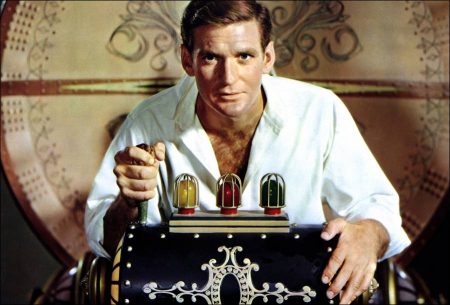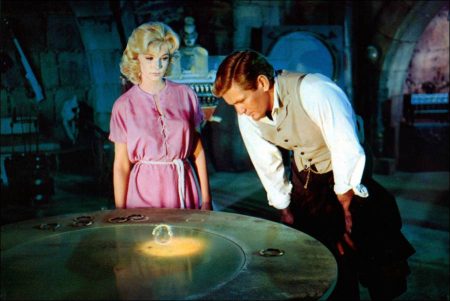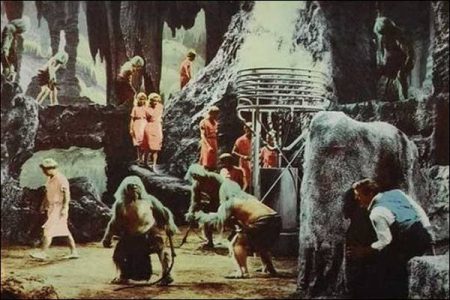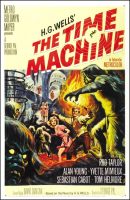Taglines: You will orbit into the fantastic future!
The Time Machine movie storyline. On January 5, 1900, a disheveled looking H.G. Wells – George to his friends – arrives late to his own dinner party. He tells his guests of his travels in his time machine, the work about which his friends knew. They were also unbelieving, and skeptical of any practical use if it did indeed work.
George knew that his machine was stationary in geographic position, but he did not account for changes in what happens over time to that location. He also learns that the machine is not impervious and he is not immune to those who do not understand him or the machine’s purpose.
George tells his friends that he did not find the Utopian society he so wished had developed. He mentions specifically a civilization several thousand years into the future which consists of the subterranean morlocks and the surface dwelling eloi, who on first glance lead a carefree life. Despite all these issues, love can still bloom over the spread of millennia.
The Time Machine (also known promotionally as H. G. Wells’ The Time Machine) is a 1960 American science fiction film in Metrocolor from Metro-Goldwyn-Mayer, produced and directed by George Pal, that stars Rod Taylor, Yvette Mimieux, and Alan Young. The film was based on the 1895 novella of the same name by H. G. Wells that was influential on the development of science fiction.
An inventor in Victorian England constructs a machine that enables him to travel into the distant future; once there, he discovers that mankind’s descendants have divided into two species, the passive, childlike, and vegetarian Eloi and the underground-dwelling Morlocks, who feed on the Eloi.
George Pal, who had made the first film version of Wells’ The War of the Worlds (1953), always intended to make a sequel to The Time Machine, but he died before it could be produced; the end of Time Machine: The Journey Back functions as a sequel of sorts. In 1985, elements of this film were incorporated into the documentary The Fantasy Film Worlds of George Pal produced and directed by Arnold Leibovit. Gene Warren and Tim Baar received the Academy Award for Best Special Effects for its time-lapse photographic effects, which show the world changing rapidly as the time traveler journeys into the future.
About the Production
George Pal was already known for his pioneering work with stop-motion animation, having been nominated almost yearly for an Oscar during the 1940s. Unable to sell Hollywood on the concept of the film, he found MGM’s British studio (where he had filmed Tom Thumb) open to his proposal.
The name of the film’s main character (alluded to in dialogue only as “George”) connects him both with George Pal and with the story’s original science fiction writer H. G. (George) Wells. The name “H. George Wells” can be seen on a brass plaque on the time machine.
Pal originally considered casting a middle-aged British actor like David Niven or James Mason as George. He later changed his mind and selected the younger Australian actor Rod Taylor to give the character a more athletic, idealistic dimension. It was Taylor’s first lead role in a feature film.

MGM art director Bill Ferrari designed the time machine. Recognized today as a classic film property, Ferrari’s machine suggested a sled made up of a large clockwork rotating disk. The disk rotated at various speeds to indicate movement through time, evoking both a spinning clock and a solar disk. In a meta-concept touch, a brass plate on the time machine’s instrument display panel identified its inventor as “H. George Wells”, though the Time Traveler is only, otherwise, referred to as “George” in the film.
The charm of a fantastic technology (time travel), wrapped in the archaic guise of brass, rivets, Art nouveau arabesques, and crystal mechanisms, was an influence on the later emergence of the steampunk genre. With a budget of under $1 million, the film could not be shot in London, where the plot sets the story.
Thus, the live-action scenes were filmed from May 25 to June 30, 1959, in Culver City, California, with the backgrounds often filled in by virtue of matte paintings & models. Some of the costumes and set were re-used from Forbidden Planet (1956) such as the Civil Defence air raid officer uniform which was the C-57-D crew uniform and the large acrylic sphere in the talking rings room, a prop from the C-57-D’s control bridge.
The Time Machine (1960)
Directed by: George Pal
Starring: Rod Taylor, Alan Young, Yvette Mimieux, Sebastian Cabot, Tom Helmore, Whit Bissell, Doris Lloyd, Paul Frees, Josephine Powell, James Skelly, Bob Barran, Paul Frees
Screenplay by: David Duncan
Cinematography by: Paul Vogel
Film Editing by: George Tomasini
Set Decoration by: F. Keogh Gleason, Henry Grace
Art Direction by: George W. Davis, William Ferrari
Music by: Russell Garcia
MPAA Rating: None.
Distributed by: Loew’s
Release Date: August 17, 1960
Views: 232



